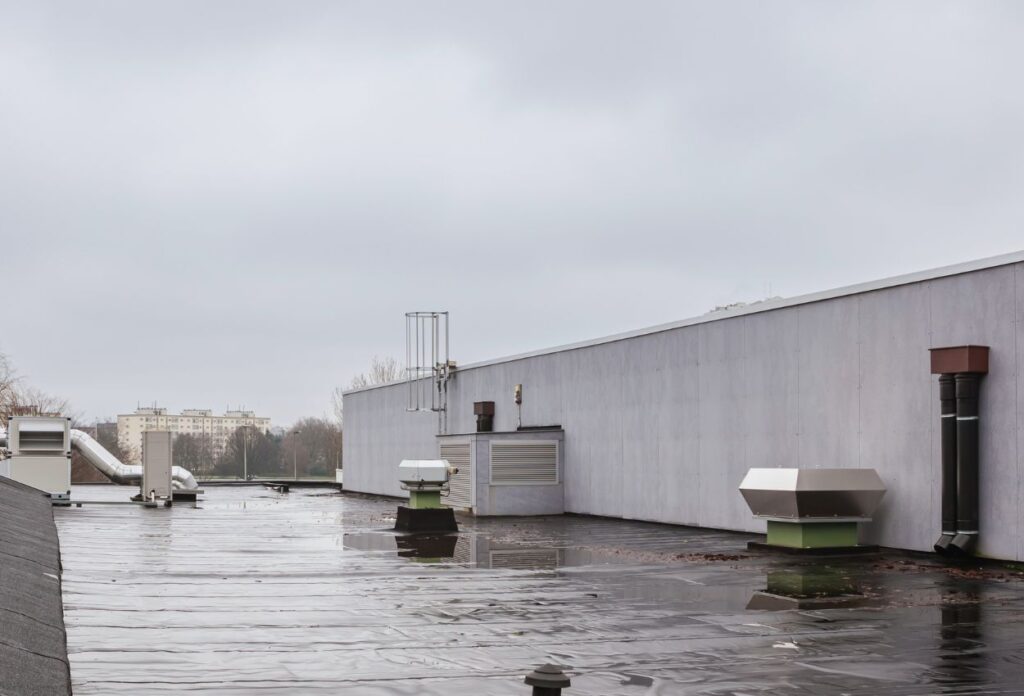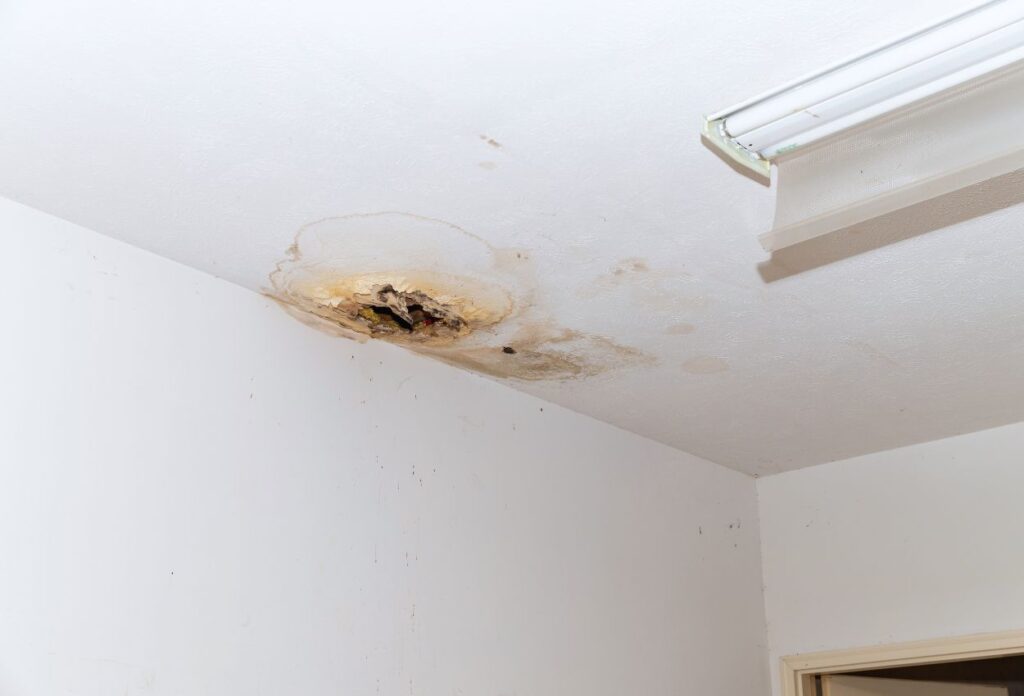The roof of your home goes through a lot through years of experiencing harsh storms, especially with heavy downpours. But there are certain issues that persist for a long time after the rain has stopped, and one of the issues you should be aware of as a homeowner or property manager is ponding water, otherwise known as pooling water, on a flat roof.
In this blog post, we will talk about what ponding water is, why it happens the most on flat roofing systems, and what you can do to avoid this situation in the future.
What Is Ponding Water?

Suppose you go on top of your flat roof to conduct a routine inspection or maintenance. Once up there, you might notice that there are puddles of water forming in certain areas on your roof, but the last amount of rain was two days ago. The water that is left sitting on your roof for more than 48 hours is known as ponding water.
While flat roofs are designed with a slight slope to facilitate drainage, improper installation, structural issues, or debris buildup can cause water to pool.
While a small amount of water on a roof might not seem alarming, prolonged ponding water can pose significant risks to the integrity of your roofing system. Your contractor might refer to this as standing water or pooling water, but it all refers to the same thing.
You should know that this can happen to any roofing system, regardless of the slope, and it can be avoided. But before we move on to how to fix ponding water, let’s take a look at why this happens in the first place.
Why Does Ponding Water Occur on Flat Roofs?
Most homeowners think that heavy rain is the main cause behind why water pools on your roof, but the truth is that this depends on several factors:
Poor Drainage Systems
One of the most common things that lead to water accumulation on your flat roof is poor drainage. Since flat roofs have a minimal slope, they are more vulnerable to pooling than pitched roofs, so they need to have excellent drainage systems in place. However, if the drainage system is not up to the task, or the existing drains are clogged, water has nowhere to go and will accumulate in low spots.
This can become an even bigger problem during periods of heavy rain as flat roofs struggle to keep up with the amount of water coming in.
Structural Issues
Over time, buildings settle and shift due to foundation movement, temperature fluctuations, or material degradation. These changes can create low spots or depressions on the roof where water naturally collects.
Roof Design Flaws
A flat roof must have a slight slope, often referred to as a ‘positive slope,’ to ensure water flows toward drains or scuppers. However, poor design or installation errors can lead to areas with inadequate pitch, resulting in standing water. Properly engineered flat roofing systems incorporate subtle slopes to prevent ponding water from becoming a recurring issue.
What Happens When Water Starts To Pool On Your Roof?
You might be assuming that just because it’s a small amount of water, there’s nothing to worry about, but as a flat roof owner, this is exactly the kind of mindset you want to avoid. While it may seem harmless at first, pooling water on your roof can lead to serious problems down the line if it’s left unchecked.
Here are some of the most common issues that result when water is allowed to pool on your flat roof:
Structural Damage
While occasional rainfall will not do much damage or add significant weight, continuous rain and water that is unable to get through a small drainage system adds considerable weight to the roof. During these types of situations, the longer the water sits on the roof’s surface, the more stress it adds to the flat roofing membrane. This can cause the roof to sag, and in the worst-case scenario, you are looking at structural failure.
Are all roofing materials equally susceptible to ponding water?
The roofing materials that are used for flat roofing systems nowadays are significantly more advanced. Most single-ply roofing membranes like TPO and EPDM fare well against water, but even the most durable materials will give out if they’re not maintained properly. You need to be especially careful if you have a built-up or tar and gravel roofing system.
Increased Risk of Leaks and Interior Damage

Even if the surface of the roof appears intact, standing water can eventually find its way into small cracks and seams. Once water infiltrates a roof’s membrane, it can travel to the underlying insulation, decking, and even the interior of the building. This can result in water stains, mold growth, and extensive interior damage that requires expensive remediation.
Mold and Mildew Growth
Persistent moisture creates an ideal environment for mold and mildew to thrive. Not only can this lead to unpleasant odors and aesthetic concerns, but mold can also pose serious health risks to occupants. Mold spores can circulate through HVAC systems, leading to respiratory issues and allergic reactions.
Reduced Roof Lifespan
A flat roof is a long-term investment, but ponding water can significantly shorten its lifespan. Constant exposure to water accelerates the wear and tear of roofing materials, causing premature aging. This means that instead of getting 20 to 30 years out of your roofing system, you may find yourself needing a replacement much sooner.
Freeze-Thaw Cycle Damage
In colder climates, ponding water poses an additional risk due to the freeze-thaw cycle. Water that remains on the roof during winter months can freeze, expanding and putting stress on the roofing material. When it thaws, it contracts, potentially causing cracks or splits along the membrane. Over time, this cycle can lead to significant roof degradation and leaks.
How Do You Stop Ponding Water On A Flat Roof?
Now that we’ve addressed the risks associated with ponding water, let’s explore some solutions. Fortunately, there are several measures you can take to fix ponding water on a flat roof.
Ensure Proper Drainage
A well-designed drainage system is essential for a flat roof’s longevity. Regularly inspect gutters, downspouts, and internal drains to ensure they are free of debris. If your drainage system is inadequate, consider adding more drains or installing tapered insulation to improve the flow of water.
Install Tapered Insulation
If your roof has areas where water consistently pools, installing tapered insulation can help create a slight slope to encourage proper drainage. This is a cost-effective way to improve water runoff and prevent standing water.
You can read more about flat roof insulation options here.
Consider a Roof Coating System
Certain roof coatings, such as silicone or elastomeric coatings, can provide additional waterproofing protection. These coatings create a seamless barrier that helps prevent water infiltration and extends the life of your roof.
Schedule Regular Roof Inspections
Routine roof inspections by a professional roofing contractor can identify early signs of ponding water and prevent minor issues from escalating. We recommend scheduling an inspection at least twice a year, ideally in the spring and fall.
At A. Fricker Roofing and Waterproofing, you can even get free roof inspections!
Trust In Our Experts to Protect Your Flat Roof
Ponding water on a flat roof is not just a minor inconvenience — it’s a serious issue that can compromise your roofing system, increase repair costs, and shorten the lifespan of your investment. As a premier roofing installation and repair company in Oklahoma, we have the expertise to diagnose and resolve ponding water issues before they become costly problems.
If you’ve noticed standing water on your flat roof or want to ensure your roofing system is in top condition, don’t hesitate to contact A. Fricker Roofing and Waterproofing at (918) 402-717.

